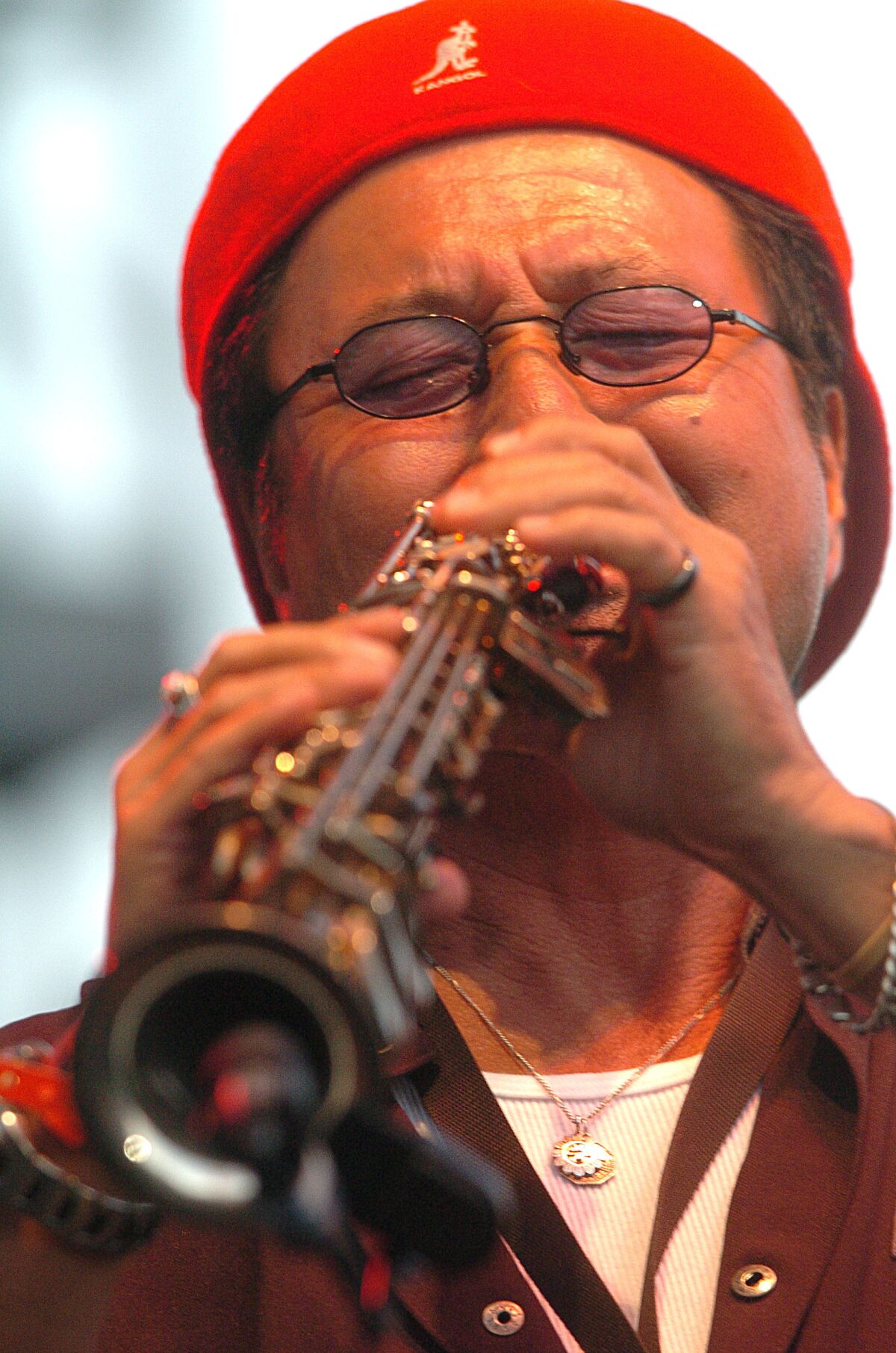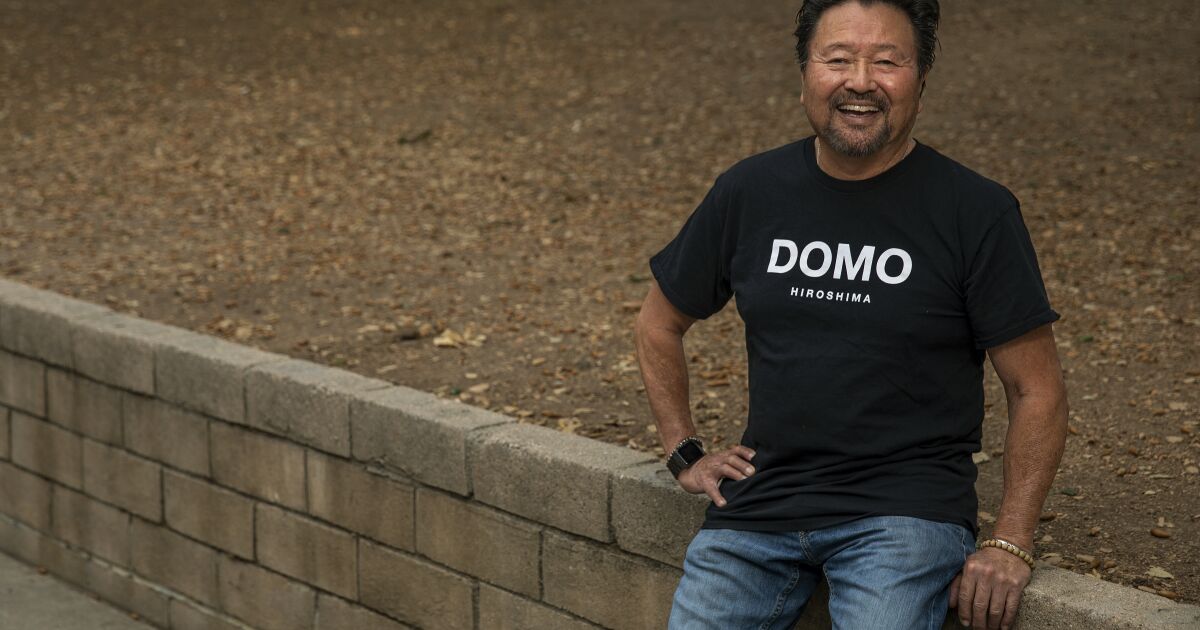Record labels didn’t know what to do with Hiroshima.
The band, led by Japanese American Boyle Heights native Dan Kuramoto, defied simple categorization. It featured Japanese instruments like taiko drums and koto yet played jazz and rhythm and blues, laced with pop and funk.
Hiroshima had found its footing in the 1970s at places like the Baby Lion Supper Club at the edge of Koreatown — a major part of the nascent Japanese American dance scene. It also drew enthusiastic cheers from a mostly Black crowd at Howard University.
Larkin Arnold, a Black record executive at Arista Records, took a chance by signing the band to its first recording contract in 1979. That propelled a decades-long run that includes nearly 20 albums and millions of records sold.
As part of its “Domo,” or “Thank You,” tour — a “wind down” or hiatus, but perhaps not a final goodbye — Hiroshima is playing Saturday night at the Aratani Theatre in Little Tokyo. Fans are reflecting on the band’s legacy as a pioneer that helped establish what it means to be Asian American and build connections with other people of color.

Hiroshima leader Dan Kuramoto performs during the Long Beach Jazz Festival at Rainbow Lagoon Park in Long Beach in August 2005.
(Steve Grayson / WireImage)
“How do we amplify the connection of our community?” said Kuramoto, 76, who usually plays saxophone and flute, including the Japanese shakuhachi. “We’re just trying to do that with music.”
When Kuramoto was growing up in Boyle Heights, graduating from Roosevelt High in 1963, the concept of pan-Asian identity did not exist. People thought of themselves as solely Chinese American, Japanese American, Filipino American or Korean American.
By the late 1960s, the movement to create an Asian American identity, on the theory that unity would create more political power, was exploding. Kuramoto became the first chair of Cal State Long Beach’s Asian American studies program while still in his early 20s. On the side, he performed music.
At a large Asian American community picnic in Griffith Park in the early 1970s, Kuramoto spotted June Okida playing the koto, a zither-like instrument that typically has 13 strings.
She took a liking to his “crazy art school band,” which was playing anything from rock to “experimental, naughty stuff,” Kuramoto said.
Kuramoto quit his job at Cal State Long Beach soon after, and the two, who married and later divorced, became the cornerstones of the band they eventually called Hiroshima — rising “from the ashes” as the Japanese city did after it was hit with a U.S. atomic bomb during World War II.
“There’s got to be some way for us to be visible as who we are,” Kuramoto said. “I wanted to try to reach out and create that voice, that image of who we are.”
At the Baby Lion Supper Club, the band initially attracted a small crowd but developed a loyal following, with hundreds packing the space. They grooved to the music in bell-bottomed trousers, wide-lapeled shirts and platform shoes, said Harry Manaka, author of “Chronicles of a Sansei Rocker” and a former owner of the bar.
“We were looking for our own identity,” Manaka said. “[Hiroshima] caught on with a niche of people that would like to hear their music. It was a different kind of music. It was like a combination of jazz and fusion, and it was a different Asian American sound.”
Record labels tried to force Hiroshima into a box. One executive wanted them to wear Asian conical hats. Another wanted them to sound like funk singer Rick James.
But the band members refused to budge. They wanted all their components, from June’s koto to Dan’s saxophone, to stand out yet be a part of the whole.
“Any Black band can play funk better than us,” Dan Kuramoto told The Times in 1988.
Much of Hiroshima’s music was instrumental. But in songs like “Thousand Cranes,” about the Japanese tradition of folding paper cranes for a wish to be fulfilled, the lyrics conveyed how the band saw itself.
In “Roomful of Mirrors,” the band sang:
In a roomful of mirrors we can pretend who we can be
A dancer in a top hat or a captain of the sea
We could make funny faces but we’re not just what you see
There’s a lot inside us we hope to grow and be
‘Cause I just wanna be, to look and sound like me
I just wanna be myself for everyone to see.
That refusal to blend in made Hiroshima appealing to many Asian Americans, especially in an era when activists successfully fought for Asian American studies programs at universities and pushed for reparations for Japanese Americans who were incarcerated by the U.S. government during World War II.
Growing up Japanese American in Monterey Park in the 1970s, Mitchell Maki thought of koto and taiko as ancient instruments played at cultural festivals like Nisei Week.
But “hearing Hiroshima play, that’s where you hear koto in a whole different way,” said Maki, chief executive of the Go for Broke National Education Center.
The band and its music became a source of pride and a reminder of what Asian American music can sound like, Maki said.
“‘Cruisin’ J-Town,’ when you hear that song, it just evokes the memories and the feelings,” he said.
Hiroshima’s distinct sound had crossover appeal, especially with the Black community. Black radio stations were often the only ones playing the band’s music, Kuramoto said.
Maki recalled getting lunch in St. Louis about a year ago with Black clergy and business leaders, who said the members of Hiroshima were among the first Asian American musicians they had ever seen or heard about.
As the band grew in popularity, with hits such as “One Wish” and albums at the top of the Billboard jazz chart, Hiroshima toured the nation while staying close to its roots.
There have been frequent shifts in the band’s membership. But Johnny Mori helmed the taiko until the early 2000s, and Dan and June Kuramoto, as well as Danny Yamamoto on drums, taiko and synthesizer, have been a constant for more than 40 years.
Japanese American journalist Ellen Endo recalled Hiroshima performing at a fundraiser for Wendy Yoshimura, a roommate of Patty Hearst and member of the Symbionese Liberation Army who was arrested in the 1970s for allegedly running a bomb factory. Yoshimura became a symbol for many Japanese Americans, who thought she had been damaged by her family’s experience in a WWII incarceration camp.
“Hiroshima never hesitated once,” Endo said.
The band drew many to community events and fundraisers, serving as what the Rev. Ken Fong called “the soundtrack and consciousness” for a burgeoning Asian American movement.
“Those of us who are not white Americans, we are ashamed of ‘our own’ instruments,” Fong said. “But [Dan Kuramoto] says, what we did is we decided to really embrace our own instruments … and even our own messages, our own narrative, our own stories.”
Hiroshima’s songs can still be heard throughout the community, from a ceremony dedicating a street corner in L.A.’s Sawtelle to Japanese American higher education leader Jack Fujimoto, to “Paper Chase,” a recently released documentary about Japanese American newspapers.
The band has faced some criticism from people in Japan who disapproved of using Japanese instruments outside of traditional music. In a 1998 interview in Japan, June Kuramoto initially cried when asked about the criticism. But after she composed herself, she told the reporter: “I love this instrument. I respect this instrument. I love the culture. … You can say whatever you want, but this is what I have to do and this is what I love to do, and this is what I need to do.”
Dan Kuramoto recalled a student from Tokyo University approaching the band after a concert and marveling at its use of the koto.
“This Japanese kid … because they want to be so American or so European, they forget their own culture. So, in a way, we can mirror both ways. ‘Don’t give this up, there’s so much beauty here,’” Kuramoto said. “To the American side, we can say, ‘This is just now another palette, another element to the music and the culture of this country that we add to.’”
As the music industry changes, Kuramoto said, the band is facing an uncertain future. That, along with June wanting a break, led to the hiatus — which he insists is not a final goodbye.
“Hopefully, we will learn some things, and hopefully we will come back and have something to say, both musically and otherwise,” he said. “Hopefully, we can contribute by being also socially active with helping our communities.”


